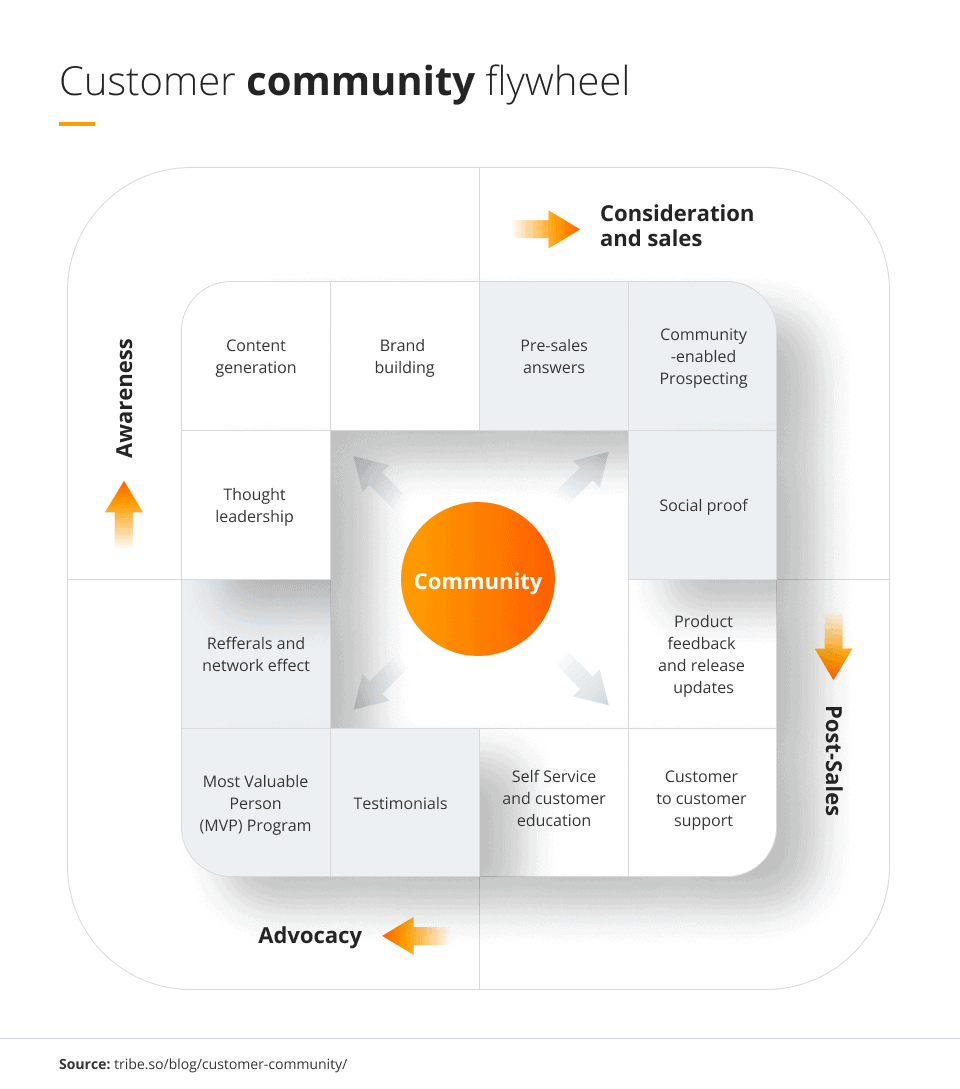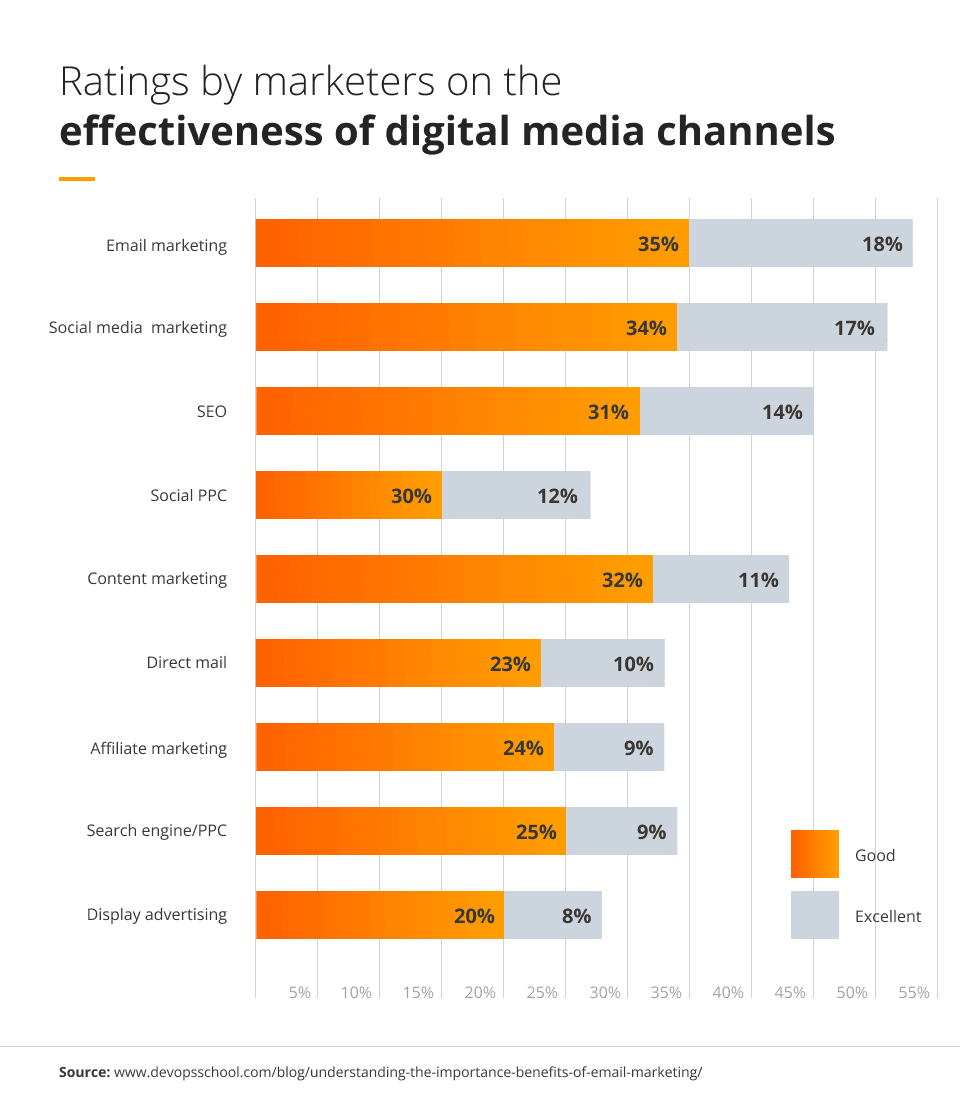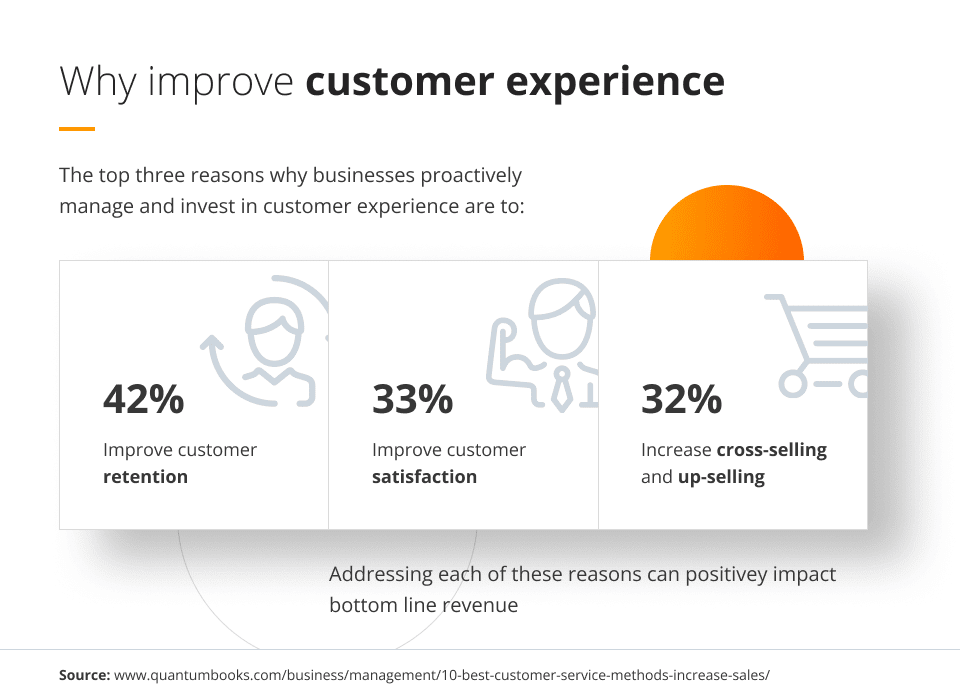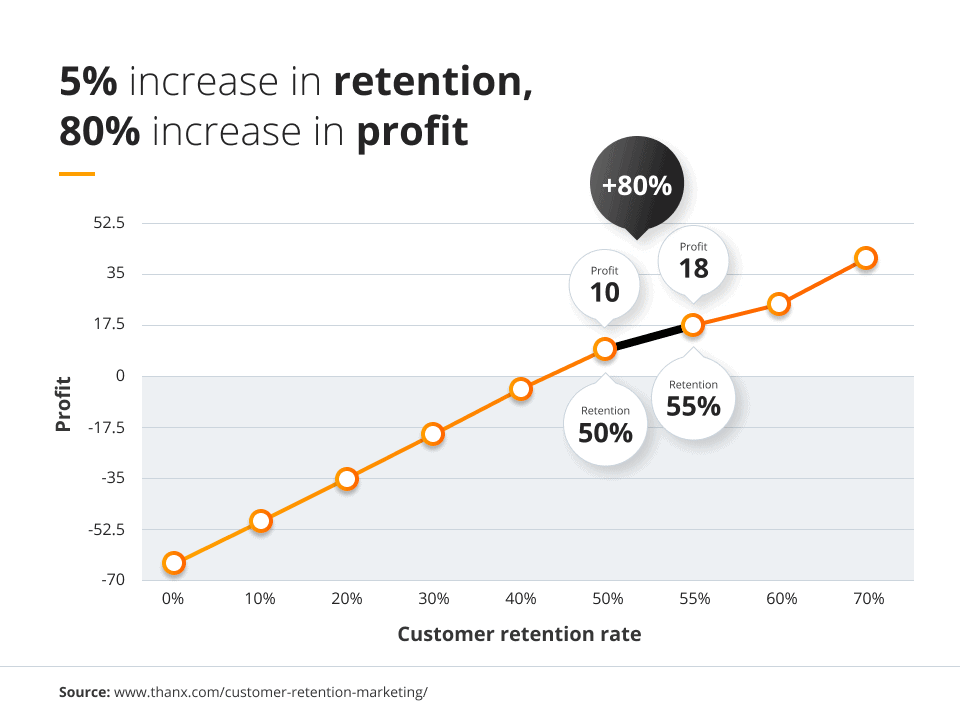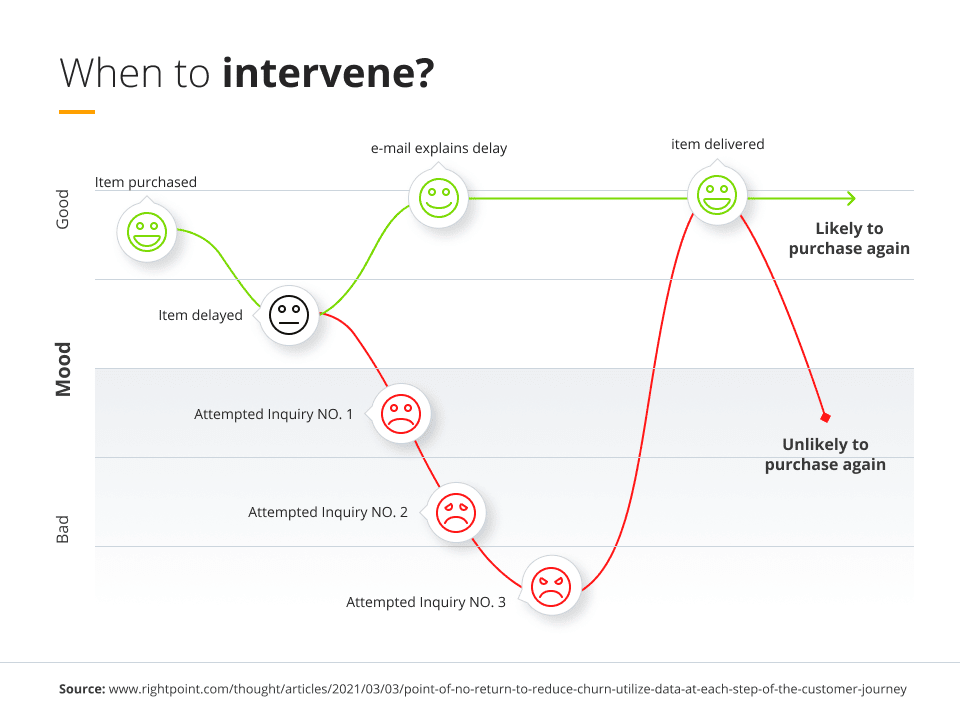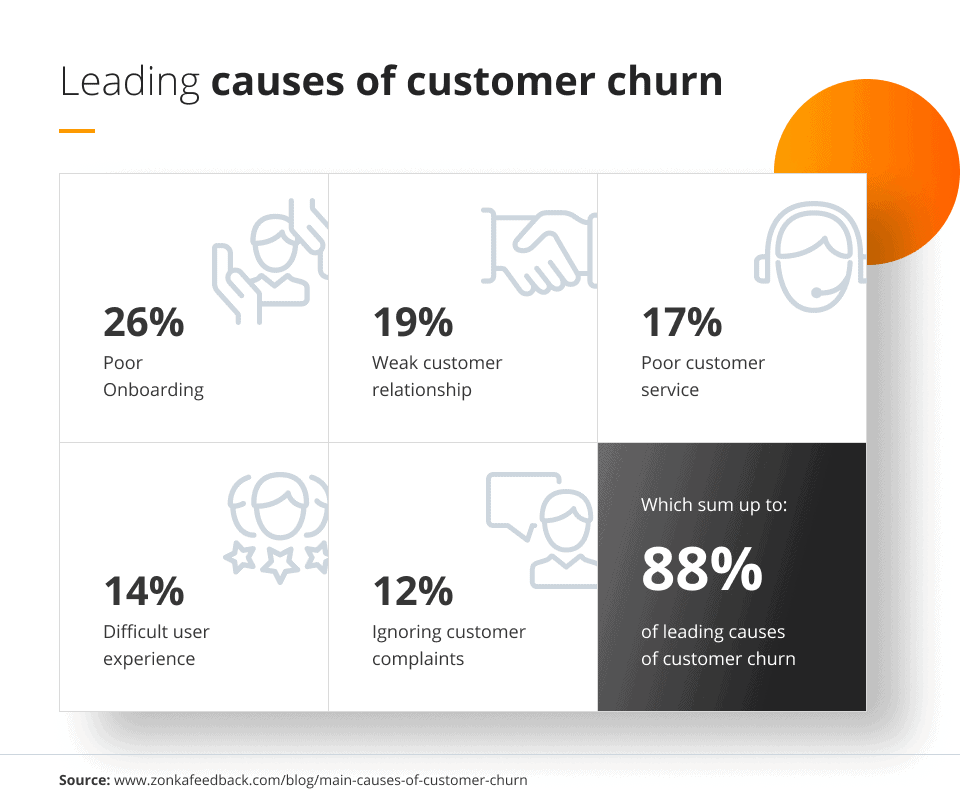
Methods to reduce customer churn rate
Churn is one of the most important metrics by which a company can be assessed. By reducing churn, or the rate at which customers leave a business and neglect giving money to the business, businesses can see rises in profits, consistency, and long-term stability.
The churn rate can quickly grow out of control if steps are not taken immediately to reduce it. By generating more value with the product, employing customer retention tools and incentives, and attacking the problem early by identifying the root causes of churn, companies can more successfully reduce their customer churn rate.
Although the cost of retaining customers is lower than acquiring a new one, there are a significant number of companies that still do not have a churn management strategy. At the end of the day, this affects their revenue, as it becomes significantly lower. Let’s look at the methods we can use to avoid it.
Generate Value with the Product
Customers will remain loyal customers with a company only if customers find the full product value as advertised by the company’s marketing team. For the most part, if a company provides that value, they keep customers happy and do not lose customers to their competitors, generating more revenue along with future revenue growth. Therefore, it is important to understand how a company can increase its products’ value and offer incentives to customers to reduce churn.
How to Increase Product Value
There are several methods sales teams of most companies can use to increase product value to retain customers. For example, companies can add or promote useful features within the product that address real-world relevant issues and make the product more useful not just for the customer but on a global scale. This objective could include features such as the make of the product, sustainability, etc.
Not only can companies focus on useful features, but they can also consider the tastes and preferences of consumers in order to encourage customers to find value in the product. The desire to purchase a product is affected by influence, trends, and emotions. A popular personality can add value by endorsing a product. Influencers can attract and gather attention towards a product, reducing customer churn rate and triggering more purchases of the product. Humor and creative customer retention strategies can also trigger impulsive buying and also prevent new customers from becoming churned customers.
Targeting customers by income can also help to increase product value. Customers churn when they believe that a product is not necessarily for them, which can be due to it being too low or too high for their price range. It is important for companies to adjust to their customer’s income during product promotion, as more customers tend to find value in a product or service when it fits into their budget.
Several valuable customers may have an account manager or various account managers who ensure that they do not stray from their budget. By tailoring strategies around income levels, doubts about product value can be erased, allowing for more product or service usage and more loyal customers. Customer retention strategies centered around price points can make customers feel more welcome during the sales process and offer incentives that engage users to purchase from the company.
Price comparison can also be used in order to increase product or service value and reduce customer churn rate. Companies must look at competitor price points and determine whether or not they have the highest product value for the lowest possible rate, making sure they stay ahead of competitors by either offering a superior price point or excellent customer service from an excellent customer support team.
In these instances, tested sales tactics should be used to ensure new customers join and that existing customers remain, making sure that customer retention extends beyond just a few months (as seen by the cancellation of month-to-month contracts) and customers choose no one else for a customer lifetime. Customer loyalty can be a difficult thing to achieve, but by providing customer satisfaction to existing customers beyond the initial purchase, companies can reduce customer churn and ensure customer lifetime value.
Encouraging Customers to Purchase Your Product
Beyond just increasing product value, companies must encourage existing customers in multiple ways to purchase their product or service. One way in which this can be done is to use technology effectively. Before product launching, a company must get the word out on their product or service to social buyers, ensuring that customer engagement will be available for purchasing the product or service. It is impossible to know exactly how many customers a company will attract nor how much effort will need to be put towards customer engagement, but using technology can help towards answering both questions.
Once people know about the product, a community of brand advocates who believe in the company’s brand and can share their individual experiences is extremely useful to cultivate. This community can be formed through excellent customer service or a smooth onboarding process that reduces revenue churn rate and reduces the number of customers lost.
Having a group of people talk about the brand can attract a brand-new audience to try products out and make a potential purchase. A deep connection with the target market can reduce the number of customers lost through customer attrition and ensure that customer lifetime value remains.
A community goes a long way, but to foster such relationships, hosting online or offline events can boost engagement among members and non-members. Events also give companies the opportunity to educate people about their product, not losing customers to ignorance, which allows people to understand how the product impacts their day-to-day life, which can help in reducing customer churn rate and revenue churn.
One last thing that businesses can do to encourage customer purchases frequently and not have a large monthly churn rate is to have a pre-product launch setup and reward attendees with exclusive discounts, time-limited vouchers, and membership incentives. Additionally, sending newsletters and email reminders to them via in-app messaging or email are also great ways to keep in touch with a large number of customers and prevent losing customers due to customer attrition or poor service.
In-app messaging would also ensure that companies see a large number of customers encouraged to purchase products, as these customers would feel more wanted and valuable, reducing customer churn rate even as customer attrition might build up.
Employ Customer Retention Tools and Incentives
Give Employees the Tools and Incentives They Need to Rapidly Address Customer Feedback
While many businesses use technology, processes, and policies to properly implement customer satisfaction and reduce customer churn rate, it is equally important to train employees to act with a customer-centered mindset. Therefore, employees should be given the tools and incentives they need to rapidly address customer feedback and keep existing customers. Giving employees these tools and incentives will help establish a culture that focuses on customers’ priorities.
Giving employees customer feedback is one of the most effective ways to reduce churn rate. Being able to quickly share customer feedback with the employees most responsible for the experience will allow them to notice their errors close to the time they made them. Identifying the root cause of poor customer service will help employees practice more proactive customer service and improve customer retention rates.
Since employees on the front lines of a company have a greater influence on the quality of customer service, they should be given greater decision-making autonomy. Greater decision-making autonomy has its limits, but properly informing employees of their powers and giving them positive reinforcement when they perform well will surely prevent customer churn.
Earn Customers’ Active Advocacy by Delighting Them at Key Moments
Oftentimes, businesses become complacent when their customer churn rate is low, and few customers are lost. However, this mindset can be harmful to a company’s long-term success. Instead, executives should continue to excite customers and further improve customer experiences. As seen in the graphic below, strengthening customer experience can improve customer retention, improve customer satisfaction, and increase cross-selling and up-selling. Aside from exiting current customers, businesses can even try to re-engage inactive customers and those that were lost.
Ensure Customers Derive Value from the Product
Similar to the concept of continuously exciting customers, it is also vital to ensure customers always derive value from the product or service. Reducing customer churn means constantly researching and analyzing the targeted customer base. On average, customers that believe they are gaining value from a product are highly unlikely to churn. A common way to ensure customers are gaining value is to invest in a customer success team that is experienced in consumer research, and that can prioritize proactive customer service.
Have a Customer Retention Strategy
To identify at-risk customers, a business must first have a customer retention strategy. Basic errors like someone’s credit card being declined and unjustly charged are often some of the most common reasons customers churn. Therefore, companies should invest in customer retention tools like smart payment tools that properly deal with expired cards, payment renewals, and payment information.
Combining the power of technology with a proper onboarding process and strong employee customer service can boost customer retention rates and lead to the production of more revenue. As seen in the graph below, a small increase in customer retention can lead to an even greater increase in profit.
Invest in a Customer Success Team
Back on the topic of investing in a customer success team, it is vital to choose a team that has expertise in dealing with customer data and data migration, real-time feedback, and addressing other customer-related issues. Furthermore, the customer success team should understand the product being sold and the value it adds to different customers. The team should thoroughly understand the value of the most loyal customer base and other high-value customers, while still addressing the needs of new customers.
Handhold New Customers
Handholding customers is a necessary part of customer retention, especially when dealing with new customers. There is a common misconception about handholding. Handholding does not mean babying the customer. It means being able to constantly identify their problem areas and develop tools to properly deal with them. It is advised to start with high-value customers and then slowly incorporate the problems of other customers.
Utilize Customer Success Tools
There are many third-party tools that help businesses get real-time data on customers’ use of the product. Segment is a popular tool used for data collection, Freshservice is commonly used for helpdesk, and Hubspot is used for marketing. Organizations underestimate the power of presenting data in a usable manner, tracking customer behavior, and automating repetitive customer service tasks. Not underestimating these objectives will boost monthly recurring revenue and customer retention rate.
Identify Root Causes of Churn Over the Entire Customer Journey
In order to maximize reducing customer churn rate, businesses must look holistically at their customer lifecycle to identify all possible sources of churn.
Broadening the Scope of Investigation
A common misconception in e-commerce is that lost customers are the result of one or two major shortcomings of an e-commerce business. On the contrary, churn is a gradual process that is usually the result of multiple issues, so it is important to take a holistic approach in order to address all potential causes when reducing customer churn rate.
This approach requires businesses to broaden the scope of their process analyses and look at the customer journey from a more general perspective. Although this process will likely be more tedious and resource intensive, it will enable businesses to identify issues early on and take steps to prevent them from escalating. In addition, this approach can help assist in building customer loyalty, improving customer acquisition, and creating a more positive customer experience overall.
Intervene at the Right Time with the Right Solution
The best approach to reducing customer churn is to intervene at the right time and fix the real issues at hand, rather than offering unrelated incentives.
With regard to when to intervene, the general rule of thumb is the earlier, the better. It is important to be able to jump on any churn-related issues before customers pass the point of no return. When reducing customer churn, the most significant interventions will always occur early in the customer lifecycle.
Another essential when considering timing is being aware of customers’ initial experiences with a business’s brand. To reduce customer churn rates, a great initial experience is key. If you can make sure that customers have a positive experience from the start, whether it be a professional website or memorable marketing, they’re much less likely to churn down the line.
In terms of providing the right solution, it is important to remain issue-focused. If you’re noticing that customers are churning due to poor customer service, then offering a discount is unlikely to solve the problem. Instead, you need to focus on improving the customer service experience.
Similarly, if you see churn due to poorly designed software, simply offering a free trial isn’t going to address the underlying issue. You need to fix the software before customers churn. Taking the time to address these real issues can be costly and time-consuming, but it’s often the best way to reduce the churn rate in the long run.
Find Root Causes and Stay Issue-Focused
The first way to reduce the churn rate is to identify the root causes of customer dissatisfaction and address them. This identification can be made by collecting customer feedback and using it to identify areas where the customer experience could be improved.
Once the root causes have been identified, the company can take an issue-focused approach to address them. This approach will require addressing each churn-inducing issue separately in order to effectively reduce the churn rate. By taking this comprehensive approach, businesses can effectively reduce churn and improve the overall customer experience. This improvement may involve making changes to business processes or improving customer service. By taking these steps, the company can reduce churn and improve its bottom line.
Conclusion
There are many methods through which churn reduction is employed throughout various industries, but without fail, organizations that do not attempt any of them will see their churn rate continue to increase and become an inescapable problem.
Reducing churn can quickly become a difficult and tedious task for businesses, but the long-term importance of reducing churn cannot be overstated. By generating more value with the product, employing customer retention tools and incentives, and attacking the problem early by identifying the root causes of churn, organizations can see improvements in customer retention and satisfaction and allow themselves a steady stream of customers for long-term stability.
